Inflammation is a Good thing?
On this edition, I am going to briefly discuss inflammation and it’s role in pain and adaptations. The majority of the general population believes that inflammation is bad. In part, this is true. However, there is also healthy inflammation which is necessary for the body to heal and adapt.
Perhaps this common misconception is rooted from pharmaceutical companies pushing the sales of their NSAIDs (non-steroidal anti-inflammatory drugs) as safe and effective. We have all taken Advil, Ibuprofen, or Motrin at some point for a variety of reasons. However, these medications also have detrimental effects to recovery, performance, and adaptability which is often overlooked.
Inflammation is one of the means by which the body triggers adaptations and healing to occur. For instance, when we lift weights, certain protein pathways are triggered which stimulates muscle growth. This process includes the influx of cellular metabolites and fluids in order to repair and create new tissue (a.k.a. Inflammation). Without this inflammation, no adaptations would occur. When we train while taking NSAIDS, these inflammatory pathways are blocked, thus, limiting the amount of healing, repair, and recovery that would normally occur.
We run into two problems when dealing with inflammation; when there is none, and when there is too much. When there is none, the body is unaware there is a need for adaption and/or healing. When there is too much, the inflammation simply gets in the way of any amount of adaptation to occur.
An easy example of when there is too much inflammation is immediately post-op following a total knee replacement. The knee swells to the size of a watermelon because of the amount of trauma during surgery. In these cases, our primary goal is to establish movement and minimize pain and swelling. If the swelling persists too long, it can create chronic pain, limitations in range of motion, capsular adhesions, etc. Once the swelling is minimal, we can begin challenging the knee to get stronger to improve function. If this process is started too early, the significant inflammation in and around the knee would prevent these adaptations to occur.
However, examples of none or too little inflammation is harder to describe. We can conceptualize that an old injury becomes chronic due to it’s lack of healing. The inflammation has come and gone, though the injury never fully healed. In these scenarios, stimulation of new inflammation through exercise or manual interventions can help to re-trigger this healing response.
These responses do not happen overnight and are not quick to heal. It is unlike medication which will have an immediate effect and possibly wear-off. It is permanent change in the tissue structure, quality, and integrity. Often times, medications are ‘band-aids’, failing to address the root of the problem. They are effective at treating the symptoms, but can leave some in chronic pain if the original injury is not addressed.
To address these causes, we have to look at many different factors. One primary factor is nutrition. Foods that contain sugar, dairy, trans fats, red and processed meats, and gluten are some of the most common inflammatory foods. Now, none of these foods in moderation are going to cause harm. It’s when they are a part of every meal, every day, when they begin to cause chronic inflammation and get in the way of our body healing and adapting on it’s own.
One of the most potent naturally-occurring anti-inflammatory foods is Curcumin (turmeric). Other anti-inflammatory foods include mega-3’s (fish oil), fruits, vegetables, and green tea. Incorporating these foods into your daily routine can help fight chronic inflammation and allow for proper healing and adaptions to occur.
IT IS IMPORTANT TO NOTE that turmeric alone is not enough. By itself, the GI system is slow to absorb Curcumin and most of what is ingested is excreted. Though, black pepper is known to be an effective agent or shuttle to facilitate absorption of curcumin into the bloodstream. Thus, be sure that in whatever dish you decide to add curcumin (or turmeric), black pepper is added as well.
Quick tip- it is very easy to add powdered turmeric, salt, and pepper to your eggs first thing in the morning. It hardly tastes any different and a great way to start your day!
Costamagna D, Costelli P, Sampaolesi M, Penna F. Role of Inflammation in Muscle Homeostasis and Myogenesis. Mediators Inflamm. 2015;2015:805172. doi: 10.1155/2015/805172. Epub 2015 Oct 5. PMID: 26508819; PMCID: PMC4609834.
Lilja M, Mandić M, Apró W, Melin M, Olsson K, Rosenborg S, Gustafsson T, Lundberg TR. High doses of anti-inflammatory drugs compromise muscle strength and hypertrophic adaptations to resistance training in young adults. Acta Physiol (Oxf). 2018 Feb;222(2). doi: 10.1111/apha.12948. Epub 2017 Sep 16. PMID: 28834248.
Maroon JC, Bost JW, Maroon A. Natural anti-inflammatory agents for pain relief. Surg Neurol Int. 2010 Dec 13;1:80. doi: 10.4103/2152-7806.73804. PMID: 21206541; PMCID: PMC3011108.
Hewlings SJ, Kalman DS. Curcumin: A Review of Its Effects on Human Health. Foods. 2017 Oct 22;6(10):92. doi: 10.3390/foods6100092. PMID: 29065496; PMCID: PMC5664031.
